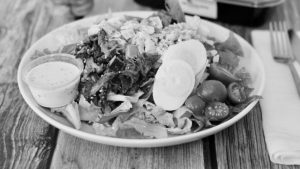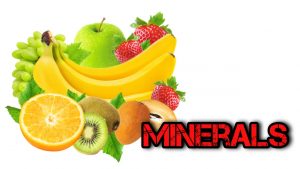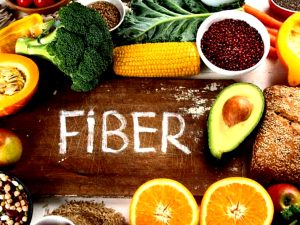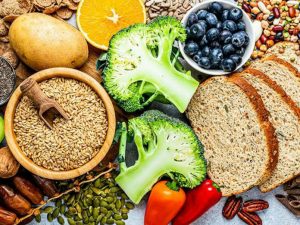The 7 Classes of Food: Examples and Functions: Food has sustained man since days of yore. Man has never lived for a long time without food. Food is pretty much as old as man. All plants and creatures need food to survive. We can briefly characterize food as a substance devoured by a life form and it offers nourishing help for such an organism. Food can be in different structures; it comes in from of plant or in animal. These supplements come as fats, nutrients, carbs, minerals and proteins of which can be found in various exhibits and assortments of spices, flavors, and dishes.
Humankind has perfectly made various cooking styles which radiate from this normal supplements. In this article, we will be looking at the different classes of food, their examples and functions. I therefore enjoin you to read this content assiduously if you want to learn anything today.
Also see: Differences between veins and arteries
Meaning and Functions of the Seven Classes of Food
1. Carbohydrates: One of the highly consumed class of food. Carbohydrate comes in different varieties and forms. A high quantity of carbohydrate is found in yam, bread, corn, rice, potato, fibers, sugar, etc. Carbohydrate has a lot of starch and provides the human body with glucose and the body converts this glucose into energy to support the body to function properly.

Some sources of carbohydrates are unhealthy while some others are healthy. The healthy sources include vegetables, fruits, beans unprocessed or minimally processed grains. They provide the body with fibers, vitamins, minerals and a lot of other important phytonutrients. On the other hand, unhealthy sources of carbohydrates includes pastries, white bread, sodas and highly processed and refined foods. Carbohydrates are also called Energy giving foods because they one of the major sources of energy.
The human body requires energy to run the systems within it. Several involuntary processes occur at each breathing moment of a human being, they are processes like respiration, blood circulation, body temperature regulation, breaking up molecules, and building muscle tissues, among others.
Energy giving foods (carbohydrates) help to carry out voluntary activities such as walking, jumping, and all kinds of physical activities, professional or recreational. A fair amount of energy is also required to maintain the body’s metabolism (conversion of ingested food into nutrients) and the heat generated is used to keep the body warm.
2. Proteins: Apart from giving us energy, we need food to build and repair worn-out tissues in the body. A growing child needs an adequate supply of bodybuilding foods to enable them mature healthy, grow stronger bones, heal the skin from wounds, etc. While pregnant women and growing children need more supplies of protein because of the several changes their bodies go through, every human irrespective of their age needs bodybuilding foods because the body is continually breaking down old tissues and needs to build new ones. Hence, there is a need for an adequate supply of bodybuilding foods.
Protein is the major source of bodybuilding foods. The importance of protein can not be overemphasized. The importance of protein can be visible in the creation process of the muscles, in the sending of messages and growth of the hair. Protein contains a high amount of energy; this energy can be derived from the meat we eat and this meat gives extra resources to grow complex nervous systems and develop a healthy brain. As a result of this energy derived from meat, it is pertinent that children, pregnant and lactating women and those recovering from injury eat meals that contains a high amount of protein.

On these grounds, protein is fundamental for acceptable well-being. Protein makes the construction of the body starting from the bone up to the skin to the hair and the muscles; every fraction of the body requires protein. Also, protein is required for body growth, maintenance, and health; to aid the body to develop hormones, antibodies and other important components also requires protein.
Proteins is made up of different components of amino acids. Meat, fish, eggs and beans are good sources of proteins. Interestingly, 16% of the body’s weight is derived from protein, therefore a good portion of protein should be present in every meal. It will help the body to function properly.
Also see: Salary structure of Doctors in the United Kingdom
3. Fats: Fat and oil are typically described and grouped together, they are usually grouped together. Fats can be characterized as solid or semi-solid triglycerides — fatty substances, while oil are clear liquids. Fats and oil are significantly sourced from plants and creatures and they are one of the three significant classes of food other than proteins and sugars.
Vegetable, marine, and creature fats and oils are for the most part accessible types of fats and oil. Fats and oils incorporate strong fats, cocoa hitter, maize oil, soybean oil, sunflower oil, nut oil, canola oil, cotton oil, olive oil, safflower oil, sesame oil, linseed oil, pumpkin oil, and others.
Fats and oils are fundamental for human sustenance as an essential wellspring of energy; calories structure a significant wellspring of energy for the body, they back and assist with creating cells and help in muscle development and mineral assimilation. Being a major source of energy, fats and oil is essential for human nutrition; As powerful anti-inflammatories, they lower the risk of arthritis, Alzheimer’s disease and cancer. Unlike most people believe, consumption of fats are not totally bad, there are healthy fats which can be found in vegetables, fish, seeds and nuts.
Fats can be saturated or unsaturated. Unsaturated fats are omega 3 and Omega 6 and they provide essential fatty acids that the body itself can not generate. Fats and oil are important to the health, however, intake of saturated animal- based fats like ice cream, cheese, red meat and butter should be highly reduced to its barest minimum. Also it is advised that trans fat should be avoided.
Recommended: Importance of Technology in Education: 10 benefits
4. Vitamins: Vitamins are imperative for warding off infection and remaining solid. The body needs these micronutrients to bolster its capacities. There are 13 fundamental vitamins that the body ought to work appropriately, counting vitamins A, C, B6, and D. Vitamins are fundamental for solid vision, skin, and bones. Vitamins lower the chance of lung and prostate cancer, and they’re effective cancer prevention agents. Vitamins like vitamin C boost the safe framework and offer assistance the body recuperate.

Eating a varied and well balanced food is encouraged. Eating routines should include meals brimming with vegetables and natural products, if this is done, you would not need to take nutrient enhancements. Vitamins are complex natural substances found in our nourishment which bolster nearly each framework within the body, counting the resistant framework, the brain and other frameworks.
This nutrients are perplexing regular substances found in our sustenance which support almost every system inside the body, and offer assistance to the body to utilize carbohydrate, fat and protein. They are additionally engaged with controlling development, making red platelets and shielding the body from unsafe free revolutionaries. Without a doubt, a modest quantity of nutrients and minerals are needed to empower the body to work appropriately and forestall sickness. Nutrients K and D can not be fabricated by the body and should come from our food.
A person may typically obtain all of the vitamins they require through a diet rich in vegetables, fruits, and lean proteins. Those who consume fewer fruits and vegetables and those who have digestive problems, on the other hand, may need to take a vitamin supplement to avoid or reduce a deficiency.
Also see: Best science courses to study in the university
5. Minerals: Minerals supports the body. They are fundamental for some body functions including building solid bones and teeth, controlling your digestion, and remaining appropriately hydrated. The most well-known minerals are calcium, iron, and zinc. They help in reinforcing bones, and assists with nerve signal transmission, keeping up with sound circulatory strain, and muscle withdrawal and unwinding.

Iron supports red blood cells and hormone creation, while zinc boosts your immune system and wound healing. strengthening bones, calcium helps with nerve signal transmission, maintaining healthy blood pressure, and muscle contraction and relaxation. Iron supports your red blood cells and hormone creation, while zinc boosts the immune system and help in wound healing.
6. Water: You can go for quite a long time without food, however you can’t last in excess of a couple of days without water. Water is totally essential for the adequate functioning of each framework in the human body. It is the primary component that the human body is made up of; about 62% of the human body weight is water.
Water is essential for plant and animal survival. It’s made up of hydrogen and oxygen. Water can be found in fruit, organic products, vegetables, and a variety of cuisine. It takes on a bigger role in digesting support. Water expands the capacity of your cerebrum and improves your disposition. In the body, it serves as a protector and an ointment.
It also aids in the flushing of poisons, the delivery of vitamins to cells, the hydration of the body, and the prevention of clogging. Lack of hydration might make you weary and make your fixation and execution difficult. It has a bigger function in absorption, body temperature regulation, reproduction, food transit, oxygen transport, and other chemical concerns in the body.
Recommended: Differences Between Natural and Artificial Selection
7. Fiber: Basically, fibre foods are those foods that are rich in fibre contents. Fibre foods and highly encouraged because of their health benefits,one of which is the fact that it helps in digestion and a smooth bowel movement.

There are quite a number of foods that are rich in fibre, some them are; Carrots, Bananas, Raspberries, Apples, Oats, Avocado, Strawberries, Pears and many others. In this article, we will be educating you on the uses of these fiber foods and the Health functions they portends.
Fiber Foods, Uses and Functions
a. Regular Bowel Movements: Dietary fibre promotes regular bowel movements and prevents constipation. Fibre, a carbohydrate the body cannot digest, is essential to digestive health. Fiber-rich meals including fruits, vegetables, whole grains, legumes, and nuts bulk up stool.

This mass makes faeces heavier and simpler for digestive system muscles to transport. Thus, frequent bowel motions lessen constipation risk. Fibre absorbs water in the digestive tract, moistening faeces. This softens faeces for easy intestinal passage. It prevents constipation-causing dry, hard stools.
Fibre also keeps the digestive tract healthy. It regulates digestion, avoiding diarrhoea and constipation. Fibre slows digestion, improving nutritional absorption. Fibre feeds helpful intestinal flora as a prebiotic. These bacteria are essential for digestive health and immunological function. Fibre promotes healthy bacteria development, which is crucial for digestive health.
b. Prevents/Treats Constipation: Constipation causes infrequent bowel motions and difficulties moving faeces. Increased fibre consumption helps prevent and relieve constipation, which is linked to low fibre intake. As you said, insoluble fibre prevents and treats constipation.
This non-soluble fibre bulks stool and promotes regular bowel motions. It speeds digestion like a natural laxative. Insoluble fibre from whole grains, cereals, and vegetables (particularly those with edible skins and seeds) adds roughage to the stool. This boosts stool volume and weight, making intestines contract more effectively. Peristalsis moves faeces through the digestive system.
c. Weight Management: High-fiber meals help reduce hunger and weight. Fruits, vegetables, whole grains, and legumes are low-calorie, high-fiber foods. This allows you to eat more of these foods without gaining weight. High-fiber meals fill you up by requiring more chewing. Weight control is supported by feeling satisfied for longer and eating fewer unhealthy snacks. Chewing high-fiber meals takes longer.
Slower eating speeds give your body more time to sense fullness, minimising the risk of overeating. Satiety: After a meal, dietary fibre increases satiety. This might help you eat less and keep to a healthy diet.
Must read: How to read for long at night with sleeping off
Conclusion: The best approach to receive enough of these six basic nutrients, as well as the key category of phytonutrients — the beneficial chemicals in colored plants that prevent disease — is to eat a diversified diet rich in fruits, vegetables, healthy proteins and fats, and whole grains. These micronutrients and macronutrients are essential for your body’s regular function and wellness. The human body is incapable of producing everything it requires to function. The six basic nutrients listed above are required for good health.
These vital nutrients are necessary for a person’s reproduction, well health, and growth, according to the World Health Organization (WHO). These necessary nutrients are divided into two groups by the WHO: micronutrients and macronutrients.

Edeh Samuel Chukwuemeka, ACMC, is a lawyer and a certified mediator/conciliator in Nigeria. He is also a developer with knowledge in various programming languages. Samuel is determined to leverage his skills in technology, SEO, and legal practice to revolutionize the legal profession worldwide by creating web and mobile applications that simplify legal research. Sam is also passionate about educating and providing valuable information to people.
Thanks
This is good
This is perfectly good
Perfect
You didn’t give me the correct answer I ask which classes of food is tea
Thank you for the explanation
This is very important to me but I think it will help us to understand it and we’ll be able to answer questions when we are asked to do it